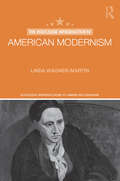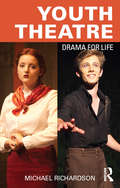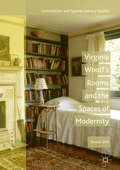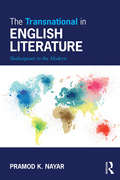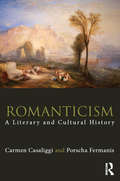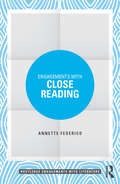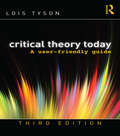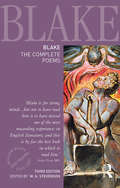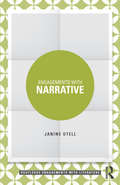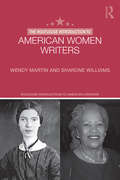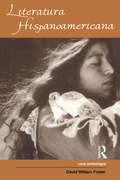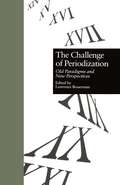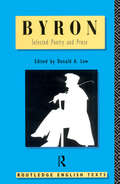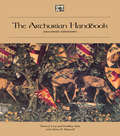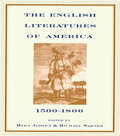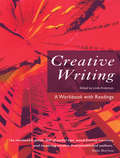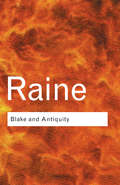- Table View
- List View
The Routledge Introduction to American Modernism (Routledge Introductions to American Literature)
by Linda Wagner-MartinThe modernist period was crucial for American literature as it gave writers the chance to be truly innovative and create their own distinct identity. Starting slightly earlier than many guides to modernism this lucid and comprehensive guide introduces the reader to the essential history of the period including technology, religion, economy, class, gender and immigration. These contexts are woven of into discussions of many significant authors and texts from the period. Wagner-Martin brings her years of writing about American modernism to explicate poetry and drama as well as fiction and life-writing. Among the authors emphasized are Ernest Hemingway, William Faulkner, Zora Neale Hurston, Langston Hughes, F. Scott Fitzgerald, Gertrude Stein, Willa Cather, John Dos Passos, William Carlos Williams, Mike Gold, James T. Farrell, Clifford Odets, John Steinbeck and countless others. A clear and engaging introduction to an exciting period of literature, this is the ultimate guide for those seeking an overview of American Modernism.
Youth Theatre: Drama for Life
by Michael RichardsonYouth Theatre: Drama for Life defines the youth theatre process, by outlining its constituent parts and explaining how these activities work in order to support young people’s development. As well as describing what?is done in youth theatre, it also explores why it’s done and how to ensure the best possible outcomes. The book is in four parts: Part 1 explores the nature and purpose of youth theatre, drawing on Michael Richardson’s extensive personal experience as a practitioner and manager. Part 2 explains, in detail, the youth theatre process: warming up, playing games, voice work, developing skills, devising and the presentation of devised work. Part 3 discusses how to create an appropriate environment within which the youth theatre process can be most effectively applied. Part 4 covers the most common applications of the youth theatre process, namely using it in different education environments; and youth theatre productions and performance. On top of this, two appendices give a list of over 60 games that are useful to use in youth theatre; and a list of recommended further reading that supports this book. As well as giving key tips and advice from his own invaluable experience, Richardson offers comments from practitioners and participants on what makes a successful youth theatre experience. Michael Richardson has worked in youth theatre for over 20 years, has been involved in the training of other practitioners, and in the strategic development of the youth theatre sector in the UK.
Virginia Woolf's Rooms and the Spaces of Modernity
by Suzana ZinkThis book provides a fascinating account of rooms in selected works by Virginia Woolf. Casting them as spaces which are at once material, textual and emotional, the volume shows Woolf’s rooms to be consistently connected to wider geographies of modernity and therefore central to her writing of gender, class, empire and the nation. The discussion moves “in and out of rooms,” from the focus on travel in Woolf’s debut novel, to the archival function of built space and literary heritage in Night and Day, the university as a male space of learning in Jacob’s Room, the iconic A Room of One’s Own and its historical readers, interior space as spatial history in The Years, and rooms as loci of memory in her unfinished memoir. Zink masterfully shows the spatial formation of rooms to be at the heart of Woolf’s interweaving of the political and the aesthetic, revealing an understanding of space as dynamic and relational.
Virginia Woolf's Rooms and the Spaces of Modernity
by Suzana ZinkThis book provides a fascinating account of rooms in selected works by Virginia Woolf. Casting them as spaces which are at once material, textual and emotional, the volume shows Woolf’s rooms to be consistently connected to wider geographies of modernity and therefore central to her writing of gender, class, empire and the nation. The discussion moves “in and out of rooms,” from the focus on travel in Woolf’s debut novel, to the archival function of built space and literary heritage in Night and Day, the university as a male space of learning in Jacob’s Room, the iconic A Room of One’s Own and its historical readers, interior space as spatial history in The Years, and rooms as loci of memory in her unfinished memoir. Zink masterfully shows the spatial formation of rooms to be at the heart of Woolf’s interweaving of the political and the aesthetic, revealing an understanding of space as dynamic and relational.
The Transnational in English Literature: Shakespeare to the Modern
by Pramod K. NayarThe Transnational in English Literature examines English literary history through its transnational engagements and argues that every period of English Literature can be examined through its global relations. English identity and nationhood is therefore defined through its negotiation with other regions and cultures. The first book to look at the entirety of English literature through a transnational lens, Pramod Nayar: Maps the discourses that constitute the global in every age, from the Early Modern to the twentieth century Offers readings of representative texts in poetry, fiction, essay and drama, covering a variety of genres such as Early Modern tragedy, the adventure novel, the narrative poem, Gothic and utopian fiction Examines major authors including Shakespeare, Defoe, Behn, Swift, Coleridge, Wordsworth, Austen, Mary Shelley, the Brontës, Doyle, Ballantyne, Orwell, Conrad, Kipling, Forster Looks at themes such as travel and discovery, exoticism, mercantilism, commodities, the civilisational mission and the multiculturalization of England. Useful for students and academics alike this book offers a comprehensive survey of the English canon questioning and analysing the transnational and global engagements of English literature.
Romanticism: A Literary and Cultural History
by Carmen Casaliggi Porscha FermanisThe Romantic period coincided with revolutionary transformations of traditional political and human rights discourses, as well as witnessing rapid advances in technology and a primitivist return to nature. As a broad global movement, Romanticism strongly impacted on the literature and arts of the late eighteenth and early nineteenth centuries in ways that are still being debated and negotiated today. Examining the poetry, fiction, non-fiction, drama, and the arts of the period, this book considers: Important propositions and landmark ideas in the Romantic period; Key debates and critical approaches to Romantic studies; New and revisionary approaches to Romantic literature and art; The ways in which Romantic writing interacts with broader trends in history, politics, and aesthetics; European and Global Romanticism; The legacies of Romanticism in the twentieth and twenty-first centuries. Containing useful, reader-friendly features such as explanatory case studies, chapter summaries, and suggestions for further reading, this clear and engaging book is an invaluable resource for anyone who intends to study and research the complexity and diversity of the Romantic period, as well as the historical conditions which produced it.
Engagements with Close Reading (Routledge Engagements with Literature)
by Annette FedericoWhat should we do with a literary work? Is it best to become immersed in a novel or poem, or is our job to objectively dissect it? Should we consult literature as a source of knowledge or wisdom, or keenly interrogate its designs upon us? Do we excavate the text as an historical artifact, or surrender to its aesthetic qualities? Balancing foundational topics with new developments, Engagements with Close Reading offers an accessible introduction to how prominent critics have approached the task of literary reading. This book will help students learn different methods for close reading perform a close analysis of an unfamiliar text articulate meaningful responses Beginning with the New Critics and recent argument for a return to formalism, the book tracks the reactions of reader-response critics and phenomenologists, and concludes with ethical criticism’s claim for the value of literary reading to our moral lives. Rich in literary examples, most reprinted in full, each chapter models practical ways for students to debate the pros and cons of objective and subjective criticism. In the final chapter, five distinguished critics shed light on the pleasures and difficulties of close reading in their engagements with poetry and fiction. In the wake of cultural studies and historicism, Engagements with Close Reading encourages us to bring our eyes back to the words on the page, inviting students and instructors to puzzle out the motives, high stakes, limitations, and rewards of the literary encounter under the pressure of this beleaguered and persistent methodology.
Critical Theory Today: A User-Friendly Guide
by Lois TysonThis thoroughly updated third edition of Critical Theory Today offers an accessible introduction to contemporary critical theory, providing in-depth coverage of the most common approaches to literary analysis today, including: feminism; psychoanalysis; Marxism; reader-response theory; New Criticism; structuralism and semiotics; deconstruction; new historicism and cultural criticism; lesbian, gay, and queer theory; African American criticism and postcolonial criticism. This new edition features: a major expansion of the chapter on postcolonial criticism that includes topics such as Nordicism, globalization and the ‘end’ of postcolonial theory, global tourism and global conservation an extended explanation of each theory, using examples from everyday life, popular culture, and literary texts a list of specific questions critics ask about literary texts an interpretation of F. Scott Fitzgerald's The Great Gatsby through the lens of each theory a list of questions for further practice to guide readers in applying each theory to different literary works updated and expanded bibliographies Both engaging and rigorous, this is a "how-to" book for undergraduate and graduate students new to critical theory and for college professors who want to broaden their repertoire of critical approaches to literature.
Critical Theory Today: A User-Friendly Guide
by Lois TysonThis thoroughly updated third edition of Critical Theory Today offers an accessible introduction to contemporary critical theory, providing in-depth coverage of the most common approaches to literary analysis today, including: feminism; psychoanalysis; Marxism; reader-response theory; New Criticism; structuralism and semiotics; deconstruction; new historicism and cultural criticism; lesbian, gay, and queer theory; African American criticism and postcolonial criticism. This new edition features: a major expansion of the chapter on postcolonial criticism that includes topics such as Nordicism, globalization and the ‘end’ of postcolonial theory, global tourism and global conservation an extended explanation of each theory, using examples from everyday life, popular culture, and literary texts a list of specific questions critics ask about literary texts an interpretation of F. Scott Fitzgerald's The Great Gatsby through the lens of each theory a list of questions for further practice to guide readers in applying each theory to different literary works updated and expanded bibliographies Both engaging and rigorous, this is a "how-to" book for undergraduate and graduate students new to critical theory and for college professors who want to broaden their repertoire of critical approaches to literature.
Blake: The Complete Poems (Longman Annotated English Poets)
by W. H. StevensonWilliam Blake (1757 - 1827) is one of the great figures in literature, by turns poet, artist and visonary. Profoundly libertarian in outlook, Blake's engagement with the issues of his day is well known and this - along with his own idiosynratic concerns - flows through his poetry and art. Like Milton before him, the prodigality of his allusions and references is little short of astonishing. Consquently, his longer viosnary poems can challege the modern reader, who will find in this avowedly open edition all they might need to interpret the poetry. W. H. Stevenson's Blake is a masterpiece of scrupulous scholarship. It is, as the editor makes clear in his introduction, 'designed to be widely, and fluently, read' and this Third Edition incorporates many changes to further that aim. Many of the headnotes have been rewritten and the footnotes updated. The full texts of the early prose tracts, All Religions are One and There is no Natural Religion, are included for the first time. In many instances, Blake's capitalisation has been restored, better to convey the expressive individuality of his writing. In addition, a full colour plate section contains a representation of Blake's most significant paintings and designs. As the 250th anniversary of his birth approaches, Blake has perhaps more readers than ever before; Blake: The Complete Poems will stand those readers, new and old, in good stead for many years to come.
Engagements with Narrative (Routledge Engagements with Literature)
by Janine UtellBalancing key foundational topics with new developments and trends, Engagements with Narrative offers an accessible introduction to narratology. As new narrative forms and media emerge, the study of narrative and the ways people communicate through imagination, empathy, and storytelling is especially relevant for students of literature today. Janine Utell presents the foundational texts, key concepts, and big ideas that form narrative theory and practical criticism, engaging readers in the study of stories by telling the story of a field and its development. Distinct features designed to initiate dialogue and debate include: Coverage of philosophical and historical contexts surrounding the study of narrative An introduction to essential thinkers along with the tools to both use and interrogate their work A survey of the most up-to-date currents, including mind theory and postmodern ethics, to stimulate conversations about how we read fiction, life writing, film, and digital media from a variety of perspectives. A selection of narrative texts, chosen to demonstrate critical practice and spark further reading and research "Engagement" sections to encourage students to engage with narrative theory and practice through interviews with scholars This guide teaches the key concepts of narrative—time, space, character, perspective, setting—while facilitating conversations among different approaches and media, and opening paths to new inquiry. Engagements with Narrative is ideal for readers needing an introduction to the field, as well as for those seeking insight into both its historical developments and new directions.
The Routledge Introduction to American Women Writers (Routledge Introductions to American Literature)
by Wendy Martin Sharone WilliamsThe Routledge Introduction to American Women Writers considers the important literary, historical, cultural, and intellectual contexts of American women authors from the seventeenth century to the present and provides readers with an analysis of current literary trends and debates in women’s literature. This accessible and engaging guide covers a variety of essential topics, such as: the transatlantic and transnational origins of American women's literary traditions the colonial period and the Puritans the early national period and the rhetoric of independence the nineteenth century and the Civil War the twentieth century, including modernism, the Harlem Renaissance, and the Civil Rights era trends in twenty-first century American women's writing feminism, gender and sexuality, regionalism, domesticity, ethnicity, and multiculturalism. The volume examines the ways in which women writers from diverse racial, social, and cultural backgrounds have shaped American literary traditions, giving particular attention to the ways writers worked inside, outside, and around the strictures of their cultural and historical moments to create space for women’s voices and experiences as a vital part of American life. Addressing key contemporary and theoretical debates, this comprehensive overview presents a highly readable narrative of the development of literature by American women and offers a crucial range of perspectives on American literary history.
Literatura Hispanoamericana: Una Antologia - An Anthology
by David W. FosterThis Spanish-language anthology contains selections by 45 Latin-American authors. It is intended as a text for upper division Latin American literature survey courses. The anthology presumes a high level of linguistic command of Spanish, and it contains footnotes to allusions and cultural references, as well as words and phrases not found in standard bilingual dictionaries used in the US. Emphasis is on major 20th-century writers, while important works from colonial and 19th-century literature as also included. The diverse selections of Literature Hispanoamericana will enable students to have a more sustained exposure to major voices of Latin American literature than possible in anthologies built around fragments. By focusing on fewer authors but more significant selections from their writings, students will have a greater grasp of major canonical figures as well as emergent voices.
Literatura Hispanoamericana: Una Antologia - An Anthology
by David W. FosterThis Spanish-language anthology contains selections by 45 Latin-American authors. It is intended as a text for upper division Latin American literature survey courses. The anthology presumes a high level of linguistic command of Spanish, and it contains footnotes to allusions and cultural references, as well as words and phrases not found in standard bilingual dictionaries used in the US. Emphasis is on major 20th-century writers, while important works from colonial and 19th-century literature as also included. The diverse selections of Literature Hispanoamericana will enable students to have a more sustained exposure to major voices of Latin American literature than possible in anthologies built around fragments. By focusing on fewer authors but more significant selections from their writings, students will have a greater grasp of major canonical figures as well as emergent voices.
The Challenge of Periodization: Old Paradigms and New Perspectives
by Lawrence BessermanFirst published in 1996. Routledge is an imprint of Taylor & Francis, an informa company.
The Challenge of Periodization: Old Paradigms and New Perspectives
by Lawrence BessermanFirst published in 1996. Routledge is an imprint of Taylor & Francis, an informa company.
Byron: Selected Poetry and Prose
by Lord Byron Donald A. LowDonald Low's collection contains Byron's most subversive, spirited and playful poetry as well as his outspoken prose. With helpful and informative annotation and a full bibliography this is an essential study aid for students.
Byron: Selected Poetry and Prose
by Lord Byron Donald A. LowDonald Low's collection contains Byron's most subversive, spirited and playful poetry as well as his outspoken prose. With helpful and informative annotation and a full bibliography this is an essential study aid for students.
The Arthurian Handbook, Second Edition: Second Edition
by Norris J. Lacy Geoffrey Ashe Debra N. MancoffEverything you ever wanted to know about King Arthur and his knights is covered in this fascinating volume: the origins of the Grail legend, the Tristan and Isolde love story in opera and literature, Spielberg's use of Arthurian motifs in Star Wars , the depiction of Arthur in paintings, the presentation of Camelot on the Broadway stage, the twitting of the legend in Monty Python and the Holy Grail and much more.This critical survey of Arthurian history and legend, archaeology, literature, and the arts from the fifth century to the present provides an introduction for the general reader and a useful summary for the specialist. It offers both historical facts and key discussions on Arthurian subjects, from post-Roman Britain to the most recent novels and films. There is a lengthy glossary of Arthurian characters, motifs, and places, a chronology of major historical and literary items, a guide to pronunciation, and a full bibliography.What's new in the Second Edition:All the material has been revised and updated to 1996 since the original 1988 edition; The chapter on modern literature has been thoroughly revised, with new material on writings from France, Germany, England, and America; The coverage of King Arthur in the arts has entirely rewritten by one of the premier authorities in Arthurian studies. Brand-new geneological charts of the ancestry of Arthur and his family and the Grail kings and knights.; A fully up-to-date chronology; Many new illustrations.
The Arthurian Handbook, Second Edition: Second Edition
by Norris J. Lacy Geoffrey Ashe Debra N. MancoffEverything you ever wanted to know about King Arthur and his knights is covered in this fascinating volume: the origins of the Grail legend, the Tristan and Isolde love story in opera and literature, Spielberg's use of Arthurian motifs in Star Wars , the depiction of Arthur in paintings, the presentation of Camelot on the Broadway stage, the twitting of the legend in Monty Python and the Holy Grail and much more.This critical survey of Arthurian history and legend, archaeology, literature, and the arts from the fifth century to the present provides an introduction for the general reader and a useful summary for the specialist. It offers both historical facts and key discussions on Arthurian subjects, from post-Roman Britain to the most recent novels and films. There is a lengthy glossary of Arthurian characters, motifs, and places, a chronology of major historical and literary items, a guide to pronunciation, and a full bibliography.What's new in the Second Edition:All the material has been revised and updated to 1996 since the original 1988 edition; The chapter on modern literature has been thoroughly revised, with new material on writings from France, Germany, England, and America; The coverage of King Arthur in the arts has entirely rewritten by one of the premier authorities in Arthurian studies. Brand-new geneological charts of the ancestry of Arthur and his family and the Grail kings and knights.; A fully up-to-date chronology; Many new illustrations.
The English Literatures of America: 1500-1800
by Myra Jehlen Michael WarnerThe English Literatures of America redefines colonial American literatures, sweeping from Newfoundland and Nova Scotia to the West Indies and Guiana. The book begins with the first colonization of the Americas and stretches beyond the Revolution to the early national period. Many texts are collected here for the first time; others are recognized masterpieces of the canon--both British and American--that can now be read in their Atlantic context. By emphasizing the culture of empire and by representing a transatlantic dialogue, The English Literatures of America allows a new way to understand colonial literature both in the United States and abroad.
The English Literatures of America: 1500-1800
by Myra Jehlen Michael WarnerThe English Literatures of America redefines colonial American literatures, sweeping from Newfoundland and Nova Scotia to the West Indies and Guiana. The book begins with the first colonization of the Americas and stretches beyond the Revolution to the early national period. Many texts are collected here for the first time; others are recognized masterpieces of the canon--both British and American--that can now be read in their Atlantic context. By emphasizing the culture of empire and by representing a transatlantic dialogue, The English Literatures of America allows a new way to understand colonial literature both in the United States and abroad.
Creative Writing: A Workbook with Readings
by Linda AndersonCreative Writing is a complete writing course that will jump-start your writing and guide you through your first steps towards publication. Suitable for use by students, tutors, writers’ groups or writers working alone, this book offers: a practical and inspiring section on the creative process, showing you how to stimulate your creativity and use your memory and experience in inventive ways in-depth coverage of the most popular forms of writing, in extended sections on fiction, poetry and life writing, including biography and autobiography, giving you practice in all three forms so that you might discover and develop your particular strengths a sensible, up-to-date guide to going public, to help you to edit your work to a professional standard and to identify and approach suitable publishers a distinctive collection of exciting exercises, spread throughout the workbook to spark your imagination and increase your technical flexibility and control a substantial array of illuminating readings, bringing together extracts from contemporary and classic writings in order to demonstrate a range of techniques that you can use or adapt in your own work. Creative Writing: A Workbook with Readings presents a unique opportunity to benefit from the advice and experience of a team of published authors who have also taught successful writing courses at a wide range of institutions, helping large numbers of new writers to develop their talents as well as their abilities to evaluate and polish their work to professional standards. These institutions include Lancaster University and the University of East Anglia, renowned as consistent producers of published writers.
Creative Writing: A Workbook with Readings
by Linda AndersonCreative Writing is a complete writing course that will jump-start your writing and guide you through your first steps towards publication. Suitable for use by students, tutors, writers’ groups or writers working alone, this book offers: a practical and inspiring section on the creative process, showing you how to stimulate your creativity and use your memory and experience in inventive ways in-depth coverage of the most popular forms of writing, in extended sections on fiction, poetry and life writing, including biography and autobiography, giving you practice in all three forms so that you might discover and develop your particular strengths a sensible, up-to-date guide to going public, to help you to edit your work to a professional standard and to identify and approach suitable publishers a distinctive collection of exciting exercises, spread throughout the workbook to spark your imagination and increase your technical flexibility and control a substantial array of illuminating readings, bringing together extracts from contemporary and classic writings in order to demonstrate a range of techniques that you can use or adapt in your own work. Creative Writing: A Workbook with Readings presents a unique opportunity to benefit from the advice and experience of a team of published authors who have also taught successful writing courses at a wide range of institutions, helping large numbers of new writers to develop their talents as well as their abilities to evaluate and polish their work to professional standards. These institutions include Lancaster University and the University of East Anglia, renowned as consistent producers of published writers.
Blake and Antiquity
by Kathleen RaineBlake was a visionary like no other. To some, like William Wordsworth, the only explanation for the remarkable spiritual world Blake witnessed and brought to life in his books was 'insane genius'. Although such a view persisted well into the twentieth century, this is the pivotal work which challenged that perspective and changed forever our understanding of William Blake's genius, placing him in the esoteric tradition. For many this book will be a revelation; for lovers of Blake it is indispensable.
